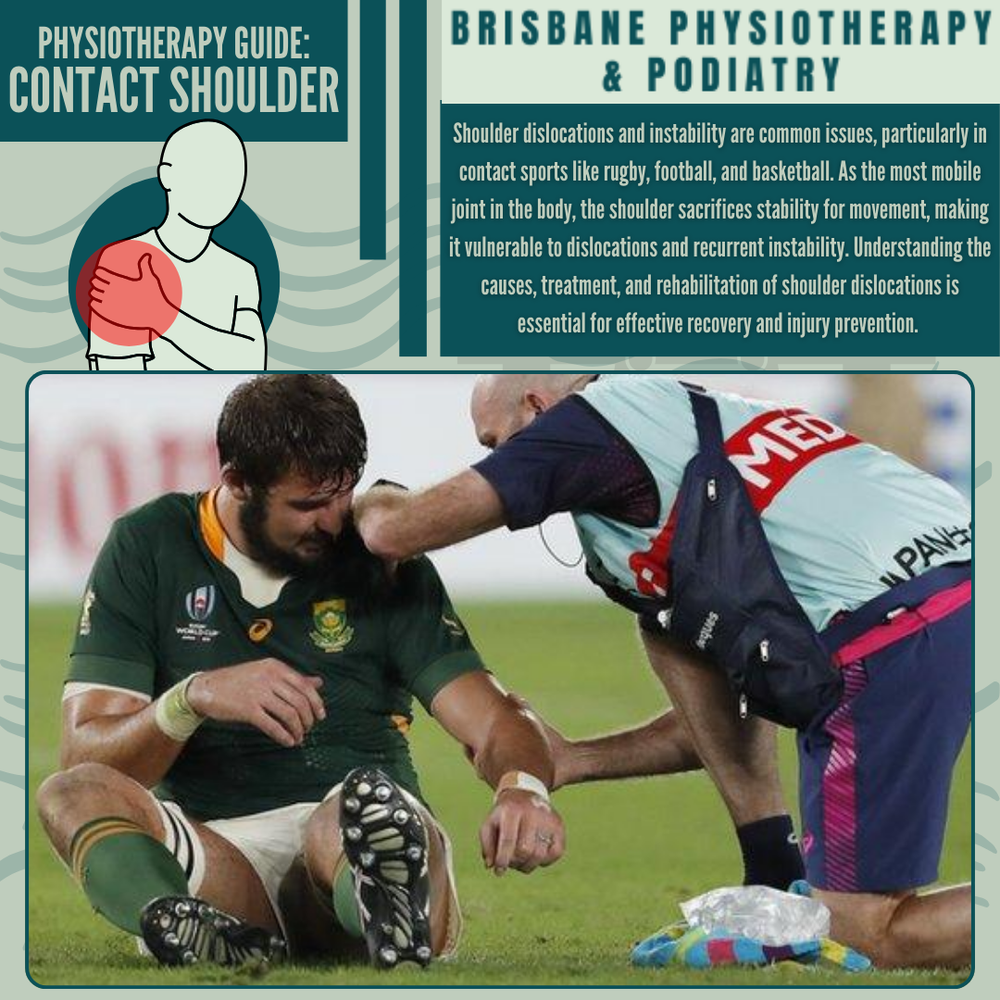Shoulder Dislocation
What is a Dislocated Shoulder?
Overview of Shoulder Dislocations
Dislocated Shoulder Description
A dislocated shoulder (correctly termed a glenohumeral joint dislocation) occurs when the head or ball of your humerus (upper arm bone) is pulled out of its normal position in the shoulder “socket” (glenoid labrum) of the scapula (shoulder blade). Acute shoulder joint dislocation is one of the most common traumatic sports injuries.
Shoulder Dislocation Presentation
Mechanism of injury
Acute trauma, either direct or indirect, associated with sudden onset of acute shoulder pain, when the shoulder is in a non-optimal and vulnerable position and is displaced out of its joint socket
May describe a feeling of the shoulder ‘popping out’.
All shoulder movement is limited and painful.
May have impaired sensation to the lateral aspect of the shoulder.
Once a dislocation occurs it is important that it is relocated as soon as possible, followed by radiographic investigations to monitor for any fractures. Ideally, the dislocated shoulder should be X-rayed prior to the relocation but this is not practical.
A dislocated shoulder can be classified into different types:
Anterior Shoulder Dislocation
Anterior shoulder dislocations are the most common type of dislocated shoulder. The humeral head moves forward, often due to an outstretched arm during a fall or a direct blow.
Associated findings post anterior dislocation include:
Bankart lesions (labrum damage at the anterior glenoid margin)
Bony Bankart lesions (anterior glenoid rim fracture)
During a dislocation the glenohumeral ligaments are stretched or torn
Findings that may also occur include:
Hill-Sachs’ lesion (posterior humeral head fracture)
Posterior or superior labrum tear.
Posterior Shoulder Dislocation
The humeral head moves backwards, often resulting from seizures, electric shocks, or direct trauma.
Inferior Shoulder Dislocation (rare)
The humeral head moves downwards, usually from high-impact trauma.
Causes of Shoulder Dislocation
Trauma: A forceful impact, such as a rugby tackle or fall, can force the shoulder out of its socket.
Hyperlaxity: Some individuals have naturally loose ligaments, making them more prone to instability.
Previous Injury: A prior dislocation increases the risk of recurrence, especially if not properly rehabilitated.
Dislocated Shoulder Symptoms
Severe pain and inability to move the arm
Visible deformity or misalignment of the shoulder
Swelling and bruising
Numbness or tingling if nerves are affected
Shoulder Dislocation Management
Shoulder Dislocation Physio
Acute Phase (7 days post-injury): Immobilization with a sling for the first few days to promote healing of the shoulder joint. Avoid vulnerable movements.
Phase 1 - Early Rehab (weeks 2-3): Manual therapy to address muscular tightness and pain. Active assisted shoulder range exercises and muscle activation and strengthening.
Phase 2 - Strength Phase (weeks 4-6): Mobility exercises, upper body strength program, stability and perturbation exercises, aerobic endurance activities, Manual therapy for muscle tightness.
Phase 3 – Functional Strengthening (weeks 7-12): advanced proprioception/perturbation exercises, advanced shoulder strengthening, sports specific drills.
Phase 4 – Dynamic Strength and Stability (5month – 1 year): Manual therapy, graded strengthening program, fitness maintenance, biomechanical retraining, plyometrics, proprioception training.
Shoulder dislocations in young athletes under 25 years old have a high rate of recurrence, leading to chronic shoulder instability.
Because of this high incidence of recurrent dislocation, an arthroscopy should be considered after shoulder dislocation as it reduces risk of recurrent instability.
When is Surgery Needed?
Surgical intervention may be required for recurrent dislocations, significant ligament damage, or if conservative treatment fails. Procedures such as a arthroscopic shoulder stabilisation, Latarjet or Bristow procedure help restore stability.
Prognosis
Once the shoulder joint has been restored to its optimal position after a shoulder dislocation, it can take up to a year for the rehabilitation to be completed (although most people return to sport after 12 weeks if non-surgical and 6-months if surgical).
Preventing Shoulder Dislocations
Strength Training: Focusing on rotator cuff and scapular stability.
Proper Technique: Avoiding risky movements and improving tackling form in contact sports.
Contact Conditioning: Maintaining upper body contact resilience through plyometric or force absorption exercises can reduce the risk of shoulder instability event.
Gradual Return to Sport: Following a structured rehabilitation programme to prevent re-injury.
Contact Shoulder
Understanding Shoulder Dislocation and Shoulder Instability in Contact Sport Athletes
Shoulder dislocations and shoulder instability are common issues, particularly in contact sports like rugby, football, and basketball. As the most mobile joint in the body, the shoulder sacrifices stability for movement, making it vulnerable to dislocations and recurrent instability. Understanding the causes, treatment, and rehabilitation of shoulder dislocations is essential for effective recovery and injury prevention.
Shoulder dislocations and instability are serious injuries that require proper rehabilitation to prevent recurrence. Physiotherapists play a crucial role in guiding recovery, strengthening the shoulder, and ensuring a safe return to activity. With the right approach, athletes can regain function and confidence while minimising future risks.




